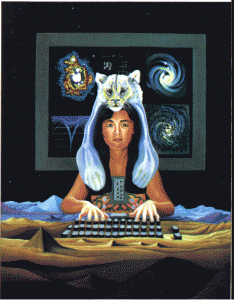 Today in my #rest320 (Gender in Global Religions), I am teaching Donna Haraway’s “‘Gender’ for the Marxist Dictionary: The Sexual Politics of a Word” (1991).* The article provides a theoretical introduction to the complexity of “gender” as a term of life and analysis. Haraway pivots between the languages/constructions of gender and sex, theories/theorists of gender, and intersections of identity in the embodied lives of historical actors and modern selves. I assign this article for several reasons, but my primary goal is to demonstrate to students the complicated grammar of gender and many attempts to define gender and sex separately. What is at stake in the definitions of sex and gender? Why do the strict boundaries often enforced between the two tell us about the study of gender and/or sex? Does the bifurcation hinder more than it helps? What work (social, political, cultural) do definitions do for us? What might definitions hide?
Today in my #rest320 (Gender in Global Religions), I am teaching Donna Haraway’s “‘Gender’ for the Marxist Dictionary: The Sexual Politics of a Word” (1991).* The article provides a theoretical introduction to the complexity of “gender” as a term of life and analysis. Haraway pivots between the languages/constructions of gender and sex, theories/theorists of gender, and intersections of identity in the embodied lives of historical actors and modern selves. I assign this article for several reasons, but my primary goal is to demonstrate to students the complicated grammar of gender and many attempts to define gender and sex separately. What is at stake in the definitions of sex and gender? Why do the strict boundaries often enforced between the two tell us about the study of gender and/or sex? Does the bifurcation hinder more than it helps? What work (social, political, cultural) do definitions do for us? What might definitions hide?
I deeply love that Haraway engages the fraught politics of language and life in the attempted divisions between gender and sex in the English-speaking world. In rereading, I also become sorrowful as I ponder the resistance (still) to gender as a category of analysis in some subfields and disciplines. Or the more insidious response that gender no longer matters as an analytical tool (I have aired these complaints before). Her insights still resonate powerfully (at least to me) in 2013. Similar debates still rage about biological determinism and social construction. Discussions of gender somehow stall (in intriguingly different ways) around the tired bifurcation of sex and gender. As it always seems, there is still work to be done.
Haraway begins by noting that she was asked to write about gender as a keyword in a Marxist dictionary because “[t]he women do not appear were they should” (49). An entry on gender becomes an opening to discuss the word “gender” in many languages and how or when gender appears as distinct from sex. Gender, as we likely know, is a complicated term caught in a genealogy of difference in politics, economics, history, and always personal lives. How do we write, analyze, and live gender? Can we find a “new genitalia of writing” (51) that allows changes in our worlds? Can we see the ties of sex, race, and religion that locate persons socially? Can a reference entry change our approaches or, more dramatically, our lives?
Haraway writes that gender foremost is “at the heart of constructions and classifications of systems of difference” (52). Sex and gender, thus, appear distinct and merged, separate and intermingled, in the “political history of the words” (52). Her entry, then, catalogs the grammars of gender from the work of Marx and Engels (“natural” division of labor of the sexes) to psychological and biological approaches to Judith Butler and Gayle Rubin to Sandra Harding and Catherine MacKinnon to Adrienne Rich to powerful critiques by feminists of color including Audre Lourde, Alice Walker, and Hazel Carby. The multiplicity and subtly of gender as a term become more clear as Haraway weaves through the many approaches to women and men, subjectivity and objectivity, sexuality and gender, reproduction and motherhood, and the lingering traces of oppression that impact individuals differently.
The most powerful sections of Haraway’s discussion of gender interrogate the relationships between race and gender. What are the racial classifications of who *counts* as a woman? Relying upon the work of Carby and others, Haraway notes how womanhood appeared conflated with whiteness because of the institution of slavery in the U.S. “Women” became objects of desire but enslaved black women were doubly objects of desire and possession. Historical circumstances and legacies of enslavement or freedom, then, create different expectations and experiences of gender. Haraway writes, “[E]ach condition of oppression requires specific analysis” (66). She urges that ” an adequate feminist theory of gender must simultaneously be a theory of racial difference” (66). She calls for a “necessarily political accounts of constructed embodiments” that both affirm and critique (67, emphasis mine). Constructed embodiments, then, must take into account what creates us: race, gender, class, and religion. We have bodies that bear the burden of our social and economic locations, our histories, our moments, and all of these appear valued or not. These values and realities press upon us. Construct us. Our bodies are never free from laden cultural meanings and expectations. We are constructed and embodied.
This should not lead to fatalism, perhaps. We can refuse and resist. We can subvert. Haraway concludes, “The refusal to become or to remain a ‘gendered’ man or a woman, then, is an eminently political insistence on emerging from the nightmare of the all too-real, imaginary narrative of sex and race” (68).
*Donna Harraway, “‘Gender’ for a Marxist Dictionary: The Sexual Politics of a Word” (1991), in Women, Gender, Religion: A Reader, edited by Elizabeth Castelli and Rosamond C. Rodman, (New York: Palgrave, 2001): 49-70.
Pingback: Teachings Bodies and Embodiment | Kelly J Baker
Pingback: Teaching Bodies and Embodiment | Bulletin for the Study of Religion
Pingback: Teaching Bodies and Embodiment | Bulletin for the Study of Religion